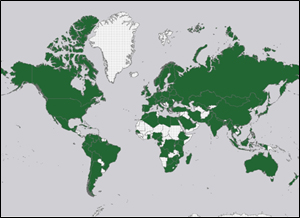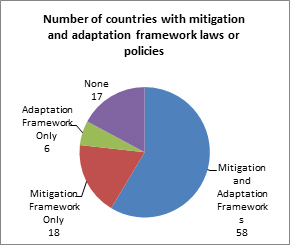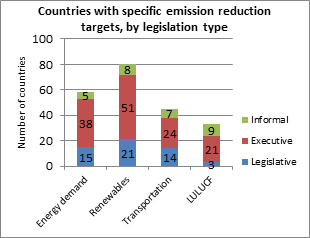Taking Control of Greenhouse Gas Emissions

June 1, 2015 – Three-quarters of the world’s annual emissions of greenhouse gases are now limited by national targets, according to a new study published today by the Grantham Research Institute on Climate Change and the Environment at London School of Economics and Political Science.
The study, led by Michal Nachmany and Sam Fankhauser, points out that 53 countries, including the 28 Member States of the European Union, have national targets that set either absolute or relative limits on annual emissions of greenhouse gases across their economies.
Lead author of the study, Michal Nachmany, said: “With three-quarters of the world’s greenhouse gas emissions now covered by national targets, we can be more confident about the credibility of the pledges that countries will make ahead of the crucial United Nations summit in Paris in December this year.
While collectively these pledges are unlikely to be consistent with the international goal of avoiding global warming of more than 2 centigrade degrees, the existence of national legislation and policies should provide the opportunity for countries to strengthen the ambition of their emissions cuts after the summit.”
The study also found that the 98 countries and the European Union together had 804 climate laws and policies at the end of 2014, compared with 426 in 2009, when a previous attempt was made in Copenhagen, Denmark, to reach an international agreement. In 1997, when the Kyoto Protocol was agreed, these countries had just 54 climate laws and policies between them.
Professor Fankhauser said: “Every five or so years the number of climate laws and policies across the world has doubled. This growing amount of legislation provides evidence that the world’s major emitters are taking serious steps to tackle climate change in their countries. By writing their intentions into law, the world’s leaders have shown that international climate change talks do lead to national action in the vast majority of countries.”
The study indicates that 75 countries plus the European Union have frameworks for limiting greenhouse gas emissions, while 64 countries have frameworks for adapting to the impacts of climate change. However, only 37 countries have completed a fully comprehensive national climate change risk assessment.
In addition, 47 countries, including the 28 Member States of the European Union, have introduced carbon pricing through either a carbon tax or a cap-and-trade system.
Key Findings
The 2015 Global Climate Legislation Study covers 98 countries plus the European Union.
 The study covers national laws and policies directly related to climate change mitigation and adaptation, passed before 1st January 2015.
The study covers national laws and policies directly related to climate change mitigation and adaptation, passed before 1st January 2015.
It covers 32+EU developed and 66 developing countries; 31+EU Annex-I and 67 non-Annex-I countries.
Taken together, the study countries produce 93 per cent of world emissions, including 46 of the world’s top 50 emitters. They are home to 90 per cent of the world’s forests.
Since 1997, the number of climate change laws and policies has doubled every 5 years
By the end of 2014 there were 804 climate change laws and policies – rising from only 54 laws and policies in 1997, and 426 in 2009 when the Copenhagen Accord was signed.
Approximately half of those (398) were passed by the legislative branch, and half (408) by the executive branch (e.g. policies, decrees).
46 new laws and policies were passed in 2014, compared with 82 in 2013.
75 countries and the EU have framework laws or policies to address mitigation; 64 countries have frameworks for adapting to the impacts of climate change
 Framework legislation has been defined as a law or regulation with equivalent status, which serves as a comprehensive, unifying basis for climate change policy, addressing multiple aspects or areas of mitigation or adaptation (or both) in an overarching manner.
Framework legislation has been defined as a law or regulation with equivalent status, which serves as a comprehensive, unifying basis for climate change policy, addressing multiple aspects or areas of mitigation or adaptation (or both) in an overarching manner.
Frameworks have been shown to encourage a strategic approach to climate policy and generate further policy action.
17 countries do not have any climate framework legislation.
Over 75 per cent of global emissions are covered by economy-wide emission reduction targets
 45 countries (including the EU as a block) have economy wide targets to reduce their emissions. Together they account for over 75 per cent of global emissions.
45 countries (including the EU as a block) have economy wide targets to reduce their emissions. Together they account for over 75 per cent of global emissions.
41 of them have economy-wide targets up to 2020, and 22 have targets beyond 2020.
86 countries have specific targets (for renewable energy, energy demand, transportation or LULUCF). 80 per cent of countries have renewable targets; the majority of them are executive policies.
The study is intended as a source of information for legislators, researchers and policy-makers. Facilitating knowledge exchange among parliamentarians was one of the primary motivations behind the Climate Legislation Study when the series was conceived by the Grantham Research Institute, LSE and GLOBE International in 2010.
The study includes detailed country chapters with a full list of laws for each of the 99 countries covered, a set of country fact sheets with key indicators, and the complete database of over 800 climate-related laws:
The full Study is available here: Global_climate_legislation_study_2015 (PDF)




